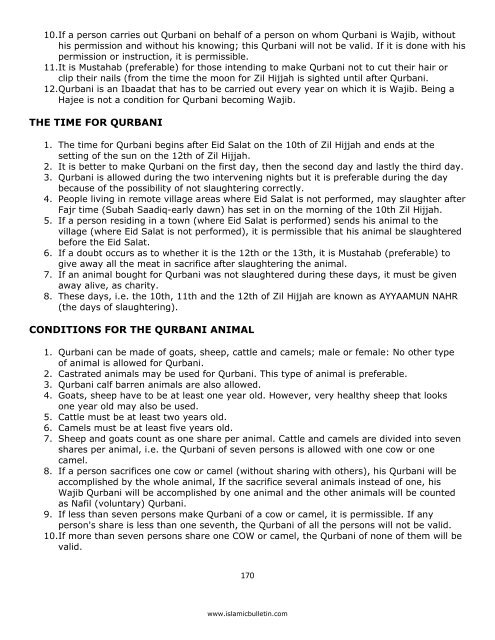You also want an ePaper? Increase the reach of your titles
YUMPU automatically turns print PDFs into web optimized ePapers that Google loves.
10.If a person carries out Qurbani on behalf of a person on whom Qurbani is Wajib, without<br />
his permission and without his knowing; this Qurbani will not be valid. If it is done with his<br />
permission or instruction, it is permissible.<br />
11.It is Mustahab (preferable) for those intending to make Qurbani not to cut their hair or<br />
clip their nails (from the time the moon for Zil Hijjah is sighted until after Qurbani.<br />
12.Qurbani is an Ibaadat that has to be carried out every year on which it is Wajib. Being a<br />
Hajee is not a condition for Qurbani becoming Wajib.<br />
THE TIME FOR QURBANI<br />
1. The time for Qurbani begins after Eid Salat on the 10th of Zil Hijjah and ends at the<br />
setting of the sun on the 12th of Zil Hijjah.<br />
2. It is better to make Qurbani on the first day, then the second day and lastly the third day.<br />
3. Qurbani is allowed during the two intervening nights but it is preferable during the day<br />
because of the possibility of not slaughtering correctly.<br />
4. People living in remote village areas where Eid Salat is not performed, may slaughter after<br />
Fajr time (Subah Saadiq-early dawn) has set in on the morning of the 10th Zil Hijjah.<br />
5. If a person residing in a town (where Eid Salat is performed) sends his animal to the<br />
village (where Eid Salat is not performed), it is permissible that his animal be slaughtered<br />
before the Eid Salat.<br />
6. If a doubt occurs as to whether it is the 12th or the 13th, it is Mustahab (preferable) to<br />
give away all the meat in sacrifice after slaughtering the animal.<br />
7. If an animal bought for Qurbani was not slaughtered during these days, it must be given<br />
away alive, as charity.<br />
8. These days, i.e. the 10th, 11th and the 12th of Zil Hijjah are known as AYYAAMUN NAHR<br />
(the days of slaughtering).<br />
CONDITIONS FOR THE QURBANI ANIMAL<br />
1. Qurbani can be made of goats, sheep, cattle and camels; male or female: No other type<br />
of animal is allowed for Qurbani.<br />
2. Castrated animals may be used for Qurbani. This type of animal is preferable.<br />
3. Qurbani calf barren animals are also allowed.<br />
4. Goats, sheep have to be at least one year old. However, very healthy sheep that looks<br />
one year old may also be used.<br />
5. Cattle must be at least two years old.<br />
6. Camels must be at least five years old.<br />
7. Sheep and goats count as one share per animal. Cattle and camels are divided into seven<br />
shares per animal, i.e. the Qurbani of seven persons is allowed with one cow or one<br />
camel.<br />
8. If a person sacrifices one cow or camel (without sharing with others), his Qurbani will be<br />
accomplished by the whole animal, If the sacrifice several animals instead of one, his<br />
Wajib Qurbani will be accomplished by one animal and the other animals will be counted<br />
as Nafil (voluntary) Qurbani.<br />
9. If less than seven persons make Qurbani of a cow or camel, it is permissible. If any<br />
person's share is less than one seventh, the Qurbani of all the persons will not be valid.<br />
10.If more than seven persons share one COW or camel, the Qurbani of none of them will be<br />
valid.<br />
170<br />
www.islamicbulletin.com


